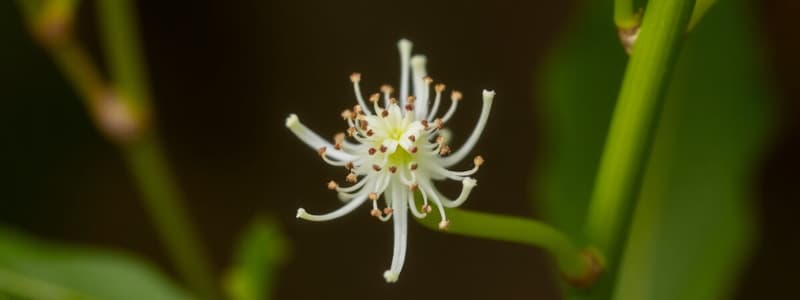Podcast
Questions and Answers
What defines a perennial plant?
What defines a perennial plant?
- A plant that requires annual replanting
- A plant that completes its life cycle in one season
- A plant that lives for three or more years (correct)
- A plant that can flower but does not produce seeds
What is the first step in sexual reproduction in plants?
What is the first step in sexual reproduction in plants?
- Formation of gametes (correct)
- Fusion of gametes
- Maturity of the plant
- Growth phase completion
During which phase do plants reproduce sexually?
During which phase do plants reproduce sexually?
- Mature phase (correct)
- Dormant phase
- Vegetative phase
- Initial growth phase
What happens after gametes fuse in plant reproduction?
What happens after gametes fuse in plant reproduction?
Which of the following is NOT characteristic of the vegetative phase in plants?
Which of the following is NOT characteristic of the vegetative phase in plants?
What part of the ovule connects it to the placenta?
What part of the ovule connects it to the placenta?
What is the function of the integuments in the ovule?
What is the function of the integuments in the ovule?
In most flowering plants, how many megaspores are functional after development?
In most flowering plants, how many megaspores are functional after development?
What is the small opening at the tip of the ovule called?
What is the small opening at the tip of the ovule called?
What term describes the process of female gametophyte formation from a single megaspore?
What term describes the process of female gametophyte formation from a single megaspore?
What is the primary function of the corolla in a flower?
What is the primary function of the corolla in a flower?
Which part of the flower is responsible for developing pollen grains?
Which part of the flower is responsible for developing pollen grains?
What does the gynoecium consist of?
What does the gynoecium consist of?
What distinguishes the androecium from the gynoecium in a flower's structure?
What distinguishes the androecium from the gynoecium in a flower's structure?
Which element of the pistil serves as the landing platform for pollen grains?
Which element of the pistil serves as the landing platform for pollen grains?
Flashcards are hidden until you start studying
Study Notes
Perennials
- Plants that live for three or more years.
- Examples include mango, peepal, and neem.
- Perennials may bloom in their first year, flowering profusely.
- Some perennials overwinter indoors (e.g., Dahlia).
Sexual Reproduction in Plants
- Begins with the formation of gametes.
- Gametes can be formed by the same individual or different individuals.
- Gametes fuse to form a zygote.
- Plants reproduce sexually during their mature phase.
- The vegetative phase precedes the mature phase of reproduction.
Flower Structure
- Calyx: Referred to as sepals, they are green in color and perform photosynthesis.
- Corolla: Referred to as petals, they are brightly colored and attract pollinators (insects or birds).
- Androecium: The male reproductive part. It consists of stamens.
- Stamen: Consists of a filament (stalk) and an anther. The anther has two lobes, each containing two pollen sacs that develop pollen grains. Each stamen is dithecous (having two thecas).
- Gynoecium: The female reproductive part. It consists of a pistil.
- Pistil: Consists of a stigma, style, and ovary. The stigma is the landing platform for pollen grains; the style connects the stigma to the ovary; the ovary contains ovules.
Flower Function
- The androecium and gynoecium are known as essential whorls of flowers.
- The female part is a long tube-like structure called a pistil, part of the gynoecium.
- The male part consists of stamens. Each stamen has two distinct parts: a filament (stalk) and the anther. Each anther has two lobes, and each lobe contains two thecas with pollen sacs.
- Calyx and corolla are collectively known as non-essential or accessory whorls.
- Calyx is known as sepals. Sepals are green in color and perform photosynthesis.
- Corolla is known as petals. Brightly colored to attract pollinators. Androecium is the male part that consists of stamens. The female part called gynoecium consists of three distinct segments called a stigma, style, and an ovary.
Pollen
- Pollen is formed in the pollen sacs in the anther.
- Pollen grains are often clustered.
Megasporangium (Ovule)
- The ovule is a small structure attached to the placenta by a stalk called the funicle.
- The body of the ovule fuses with the funicle at the region called the hilum.
- Each ovule has one or two protective envelopes called integuments.
- The integuments encircle the ovule except at the tip, where a small opening called the micropyle is present.
Female Gametophyte
- In most flowering plants, one of the megaspores is functional, while the other three degenerate.
- The functional megaspore develops into the female gametophyte (embryo sac).
- This method of embryo sac formation from a single megaspore is termed monosporic.
Studying That Suits You
Use AI to generate personalized quizzes and flashcards to suit your learning preferences.




